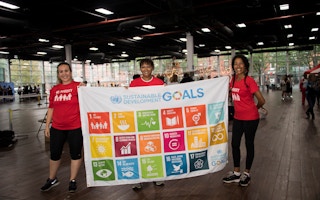I’ve never been overly convinced of the value of the United Nation’s Sustainable Development Goals (SDGs). Where the previous iteration, the Millennium Development Goals (MDGs) provided a focused rallying cry for the international development community, I have viewed the SDGs as attempting to be everything to everyone, and lacking the punch to catalyse serious intention.
And yet, my team and I encounter leaders and conversations every day that seem to centre on these 17 “Global Goals”. What seemed to be an exercise in lip service has actually become an entry point into discussions about global development for those who may have previously lacked the language or even the awareness to engage, particularly in the private sector.
Leaders in corporate social responsibility and philanthropy are the most obvious for whom the SDGs have provided a framework to guide and measure their activities. Beyond these traditional approaches lie companies seeking to build sustainability and development outcomes into their core business strategies—those handful of forward-thinking organisations who see that commercial growth is inextricably linked to the social wellbeing of the ecosystems in which they operate, from their workforce to their supply chains to their customers.
The engagement of these private sector players is crucial to development in the long-term, (whether guided by the SDGs or not), but real change happens slowly and requires resources.
If we’re to accept the premise that the SDGs represent a valid framework for the sum total of development goals we need to accomplish (or at least have provided the necessary players with the structure and language to engage), then we know that current funding levels don’t come close to what’s needed. The oft-quoted number is USD $2.5 trillion per year—that’s the gap between funding from donor governments, charities, philanthropy, etc. and what the SDGs will cost to achieve. So how do we close this gap?
For years, I’ve been one of a now-growing chorus who believes that impact investing is a tool that can be accessed for development funding. The key has always been to unlock more private capital, and impact investments (investments that generate a measurable social impact alongside a financial return) are increasing in popularity with no signs of slowing down. According to the Global Impact Investing Network (GIIN), there is now $228 billion invested in impact funds, up from $77 billion in 2015.
As CEO of Enclude, a financial advisory firm that specialises in mobilising private capital toward social outcomes, Laurie Spengler agrees. “If we’re going to achieve the SDGs, we absolutely need to tap private capital to address development opportunities,” she says. (Full disclosure: Palladium recently acquired Enclude, a transition that Spengler described “as a sign of the impact investing industry maturing with key players teaming up to accelerate growth.”)
But while impact investing may be the key to closing the SDG-funding gap, it’s the SDGs themselves that are helping to unlock one of the biggest challenges in the impact investment space: how to measure social return on investment, credibly and consistently.
Measurement is crucial to this work, as investors rightfully demand the same level of rigour around their social impact as their financial returns, and the SDGs provide targets and metrics that can be combined with a theory of change model toward actual, sustainable development outcomes. With $250 trillion in global private wealth available for investment, the potential impacts are incredible.
For now, despite the increase in popularity, impact investing remains relatively niche, and will require common principles, reporting standards, and measurement processes to gain widespread acceptance. The SDGs may not be perfect, but the framework they provide gets us closer to meeting these requirements, and to leveraging private capital toward social outcomes in previously impossible ways.
Christopher Hirst is the chief executive of the global impact firm Palladium. This story was published with permission from Thomson Reuters Foundation, the charitable arm of Thomson Reuters, that covers humanitarian news, women’s rights, corruption and climate change. Visit news.trust.org.









